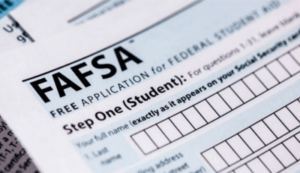Attending college is a big financial decision that can have long-term impacts on your future. While it would be ideal to attend college without taking on any debt, this is not always realistic. Tuition, housing, textbooks, and other expenses add up quickly, making student loans a necessity for many. According to Forbes, 55% of students from four-year institutions graduate with student loan debt. If you find yourself in a position where you need to take out student loans, it’s important to know the difference between federal and private loans so you can make the best financial decision for your future.
Federal Student Loans
Qualifying
Federal student loans are funded by the government and are typically the first choice for students who need to borrow money. To qualify, you must fill out the Free Application for Federal Student Aid (FAFSA). The application collects information on your dependency status, income, and family financial situation to determine your eligibility for various types of financial aid. The amount of loan money you are offered varies based on the information you provide in the FAFSA. Unlike private loans, federal loans do not require a credit check, making them more accessible to students with little to no credit history.
Interest Rates
One of the biggest advantages of federal student loans is their reasonable interest rates. According to Business Insider, for the 2024-2025 school year, the interest rate on undergraduate federal student loans is 9.08%. This rate is typically lower than what most private lenders offer. Additionally, federal loans have fixed interest rates, meaning they will not change over time. This provides borrowers with stability and predictable payments in the future.
Repayment
Another major benefit of federal student loans is their flexible repayment options. Borrowers can choose from several plans, including standard repayment, graduated repayment, and income-driven repayment plans that adjust monthly payments based on earnings. Certain federal loans, like subsidized loans, do not accrue interest while you are in school or during approved deferment periods. Additionally, federal student loans may be eligible for loan forgiveness programs, such as Public Service Loan Forgiveness (PSLF), which can significantly reduce or eliminate loan balances for those who work in qualifying industries.

Image from https://www.leonardandrew.com/uploads/2/5/7/7/25774263/fafsa-stock_orig.png.
Private Student Loans
Qualifying
Private student loans are issued by banks, credit unions, and online lenders. Unlike federal loans, private lenders require a credit check to determine eligibility, loan amounts, and interest rates. Students who do not have a strong credit history may need a cosigner, such as a parent or guardian, to secure a loan.
Interest Rates
Interest rates on private loans vary depending on the borrower’s credit score. They can be either fixed or variable, meaning they might change over time. In many cases, private loan interest rates are higher than federal loan rates, making repayment more expensive in the long run.
Repayment
Private student loans begin accruing interest as soon as the loan is disbursed. Unlike federal loans, they do not offer income-driven repayment plans or loan forgiveness programs. Additionally, most private loans do not allow deferment periods, meaning students may have to start making payments while still in school.

Image from https://cdn.financial-verge.com/wp-content/uploads/sites/166/2020/11/1.-types-of-loans.png.
Which is Better?
When it comes to paying for college, federal student loans are generally the better option. Their lower interest rates, flexible repayment plans, and eligibility for loan forgiveness programs make them easier to manage. Additionally, federal loans provide protections such as deferment and forbearance, which can help borrowers experiencing financial hardship.
However, private student loans can serve as an additional financial resource if federal loans and other financial aid are not enough to cover college costs. Before taking out a private loan, students should carefully consider their financial situation, repayment terms, and interest rates. Comparing lenders and understanding the long-term commitment of student debt can help borrowers make the best choice for their education and future financial health.
Overall, borrowing responsibly and understanding your repayment obligations will help you manage student debt effectively and set yourself up for financial success after graduation.









